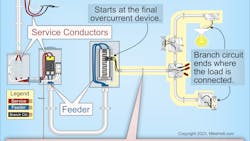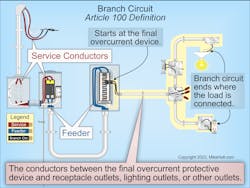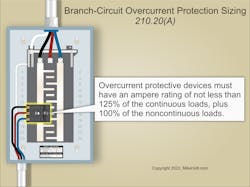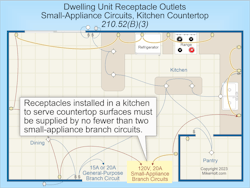Article 210 provides the general requirements for branch circuits not over 1,000VAC or 1,500VDC. These include requirements for conductor sizing, overcurrent protection, identification, GFCI and AFCI protection, receptacle outlets, and lighting outlets.
A “branch circuit” consists of the conductors between the final overcurrent protective device (OCPD) and the receptacle outlets, lighting outlets, or other outlets [Art. 100], as shown in Fig. 1.
Multiwire branch circuits
A “multiwire branch circuit” consists of two or more circuit phase conductors with a common neutral conductor [Art. 100]. This type of circuit has a voltage between the phase conductors and an equal difference of voltage from each phase conductor to the common neutral conductor.
Except as permitted in Sec. 300.3(B)(4), all conductors of a given multiwire branch circuit must originate from the same equipment containing the branch-circuit OCPDs [Sec. 210.4(A)]. All multiwire branch-circuit conductors (including the neutral and EGCs) must run in the same raceway, cable, trench, cord, or cable tray [Sec. 300.3(B)], except as permitted by Sec. 300.3(B)(1) through (4).
Each multiwire branch circuit must have a means to simultaneously disconnect phase conductors at the circuit origin (e.g., the breaker) [Sec. 210.4(B)]. Individual single-pole circuit breakers with handle ties identified for the purposes or a circuit breaker with a common internal trip can be used for this application [Sec. 240.15(B)(1)].
Multiwire branch circuits must supply only line-to-neutral loads [Sec. 210.4(C)] (two exceptions exist). Phase and neutral conductors of a multiwire branch circuit must be grouped by wire markers, cable ties, or similar means in at least one location within the enclosure per Sec. 200.4(B) [Sec. 210.4(D)].
Conductor Identification
The branch-circuit neutral conductor must be identified per Sec. 200.6 [Sec. 210.5(A)].
Equipment grounding conductors (EGCs) of the wire type can be bare, covered, or insulated [Sec. 210.5(B)]. Insulated EGCs 6 AWG and smaller must have a continuous outer finish — either green or green with one or more yellow stripes [Sec. 250.119(A)]. Insulated EGCs 4 AWG and larger can be permanently reidentified with green marking at the time of installation where accessible [Sec. 250.119(B)].
Circuit phase conductors must be identified per Sec. 210.5(C). For example, where premises wiring is supplied from more than one nominal voltage system, the phase conductors of branch circuits must be identified by phase or line and by nominal voltage system at termination, connection, and splice points per Sec. 210.5(C)(1)(a) and (b). Different systems within the premises with the same nominal voltage can use the same method of identification.
Number of circuits required
You determine the required number of branch circuits by dividing the total calculated load in amperes by the ampere rating of the circuit [Sec. 210.11(A)]. If the load is calculated on VA per sq ft, the wiring system must serve the calculated load. The load must be evenly proportioned among the branch circuits within the panelboard [Sec. 210.11(B)].
Dwelling units
Per Sec. 210.11(C), you must have:
(1) At least two 20A, 120V branch circuits to supply receptacle outlets in a dwelling unit kitchen, dining room, breakfast room, pantry, or similar area (food preparation or serving areas) per Sec. 210.52(B).
(2) One 20A, 120V branch circuit to supply the receptacle outlet for dwelling unit laundry equipment per Sec. 210.52(F). This circuit can supply other receptacles in the laundry area, but not lighting outlets or receptacle outlets outside the laundry area.
(3) At least one 20A, 120V branch circuit to supply the dwelling unit bathroom sink receptacle outlet(s) required by Sec. 210.52(D). This circuit cannot supply lighting outlets or any other receptacle outlets. Exception: A single 20A, 120V branch circuit can supply all the outlets in a single bathroom area.
(4) One 20A, 120V branch circuit in dwelling unit garages with electric power. This circuit can supply receptacle outlets in addition to the vehicle bay receptacle outlet(s) required by Sec. 210.52(G)(1). This circuit cannot supply outlets in other areas of the dwelling unit. A branch circuit rated 15A or greater is permitted in addition to the required 20A, 120V garage vehicle bay branch circuit. Two exceptions exist.
Conductor sizing
Branch circuits must be sized to have an ampacity per Sec. 210.19(A) through (D). For example, branch-circuit conductors must be sized to have an ampacity of at least the largest of Sec. 210.19(A)(1) or (2):
Branch-circuit conductors must be sized to have an ampacity of at least 125% of the continuous loads, plus 100% of the noncontinuous loads, based on the temperature rating of equipment per Sec. 110.14(C)(1) and Table 310.16, prior to conductor ampacity correction and/or adjustment.
Exception: If the assembly, including the OCPDs protecting the branch circuits, is listed for operation at 100% of its rating, the ampacity of the branch-circuit conductors can be sized at 100% of the continuous load plus the noncontinuous load.
Conductors must be sized to have an ampacity of at least 100% of the total load after conductor ampacity correction and/or adjustment per Table 310.15(B)(1)(1) and Table 310.15(C)(1).
Overcurrent protection
Branch-circuit conductors and equipment must be protected by OCPDs with a rating or setting that complies with 210.20(A) through (D).
For example, branch-circuit OCPDs must have an ampere rating of at least 125% of the continuous loads, plus 100% of the noncontinuous loads [210.20(A)], as shown in Fig. 2.
Receptacle rating
A single receptacle must have an ampere rating of at least the rating of the circuit OCPD [Sec. 210.21(B(1)].
Where connected to a branch circuit supplying two or more receptacles or outlets, a receptacle cannot supply a total cord- and plug-connected load greater than the maximum specified in Table 210.21(B)(2) [Sec. 210.21(B)(2)]. Where multiple receptacles are connected to a branch circuit, their ampere ratings must be per Table 210.21(B)(3) [Sec. 210.21(B)(3)].
Required outlets
Receptacle outlets in dwelling units for specific appliances must be within 6 ft of the intended location of the appliance unless this distance is modified elsewhere in the Code [Sec. 210.50(C)].
Section 210.52 provides the requirements for 15A and 20A, 125V receptacle outlets in dwelling units. Receptacles or receptacle outlets in these four locations do not count as the required 15A and 20A, 125V receptacle outlets under this section:
(1) Receptacles that are part of a luminaire or appliance.
(2) Receptacles controlled by a listed wall-mounted control device per Sec. 210.70(A)(1) Ex 1.
(3) Receptacle outlets within cabinets or cupboards.
(4) Receptacle outlets more than 5½ ft above the floor.
A receptacle outlet must be installed in the walls for every kitchen, dining room, breakfast room, pantry, or similar area per the requirements of Sec. 210.52(1), (2), (3), and (4). For example, floor receptacle outlets within 18 in. of the wall can be counted as the required wall space receptacle outlet but receptacle outlets installed for countertop surfaces required by Sec. 210.52(C) cannot.
In any kitchen, dining room, breakfast room, pantry, or similar area of a dwelling unit, the following must be supplied by two or more 20A, 120V small-appliance branch circuits [Sec. 210.11(C)(1)]:
- Wall and floor receptacle outlets covered by Sec. 210.52(A).
- Countertop outlets covered by Sec. 210.52(C).
- Receptacle outlets for refrigerators. Exception No. 2: An individual 15A or larger branch circuit can supply a receptacle outlet for a specific appliance such as a refrigerator.
The 20A, 120V small-appliance circuits required by Sec. 210.11(C)(1) cannot supply lighting outlets or receptacle outlets outside the kitchen, dining room, breakfast room, pantry, or similar area. Exception No. 2: A receptacle outlet for a gas-fired range, oven, or counter-mounted cooking unit is permitted on the 20A, 120V small-appliance circuit.
Receptacles that serve countertop surfaces must be supplied by at least two small-appliance branch circuits, either or both of which can supply receptacle outlets in the same kitchen, dining room, breakfast room, pantry, or similar area as specified in Sec. 210.52(B)(1), as shown in Fig. 3.
In kitchen, dining room, breakfast room, pantry, or similar area of dwelling units, receptacle outlets for countertop and work surfaces 12 in. or wider must be installed per Sec. 210.52(C)(1) through (C)(3) and don’t count toward the receptacle outlets for wall space required by Sec. 210.52(A).
The receptacle requirements for these spaces are detailed further in Sec. 210.52(B) and (C).
Other dwelling unit locations with detailed requirements are:
- Bathroom sinks [Sec. 210.52(D)].
- Outdoors [Sec. 210.52(E)].
- Laundry areas [Sec. 210.52(F)].
- Garages, basements, and accessory buildings [Sec. 210.52(G)].
- Hallways [Sec. 210.52(H)].
- Foyers [Sec. 210.52(I)].
Avoiding Code violations
We haven’t covered every requirement for branch circuits. We’ve just hit the highlights. For some jobs you may encounter, the requirements can be confusing unless you’ve already invested time in becoming familiar with them.
For the typical design engineer or electrician, it pays to systematically study Art. 210 because so much of your work involves branch circuits. A good method is to set aside a specific time each month to read a chunk of Art. 210. But pause as you go, and think of a project you recently worked on — and then determine how what you just read would apply to it.
About the Author

Mike Holt
Mike Holt is the owner of Mike Holt Enterprises (www.MikeHolt.com), one of the largest electrical publishers in the United States. He earned a master's degree in the Business Administration Program (MBA) from the University of Miami. He earned his reputation as a National Electrical Code (NEC) expert by working his way up through the electrical trade. Formally a construction editor for two different trade publications, Mike started his career as an apprentice electrician and eventually became a master electrician, an electrical inspector, a contractor, and an educator. Mike has taught more than 1,000 classes on 30 different electrical-related subjects — ranging from alarm installations to exam preparation and voltage drop calculations. He continues to produce seminars, videos, books, and online training for the trade as well as contribute monthly Code content to EC&M magazine.



